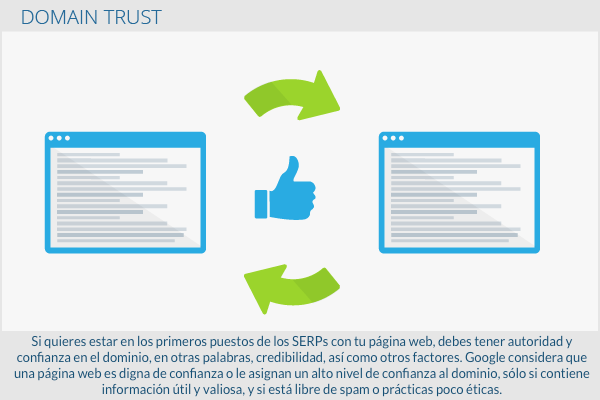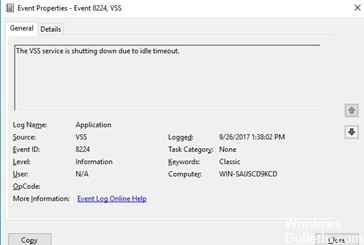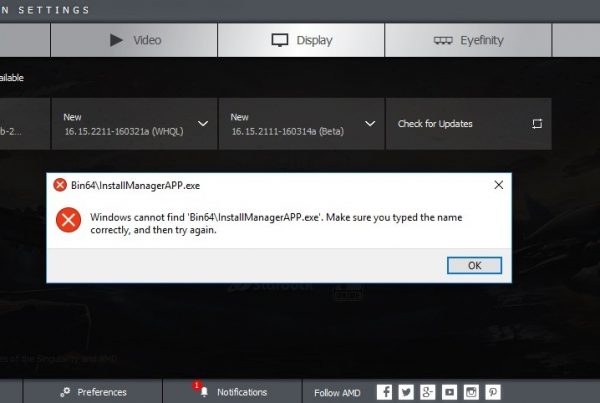Google and other search engines consider a web page to be trustworthy or assign a high level of trust to the domain, only if it contains useful and valuable information, and if it is free of spam or unethical practices. If you need to be in the top positions of the SERPs with your website, you have to have authority and domain trust, in other words, credibility, as well as other factors. The trust in the domain it can also be increased by inbound links or the age of the domain. In general, there are many aspects that can affect the domain trust.
Background
For a long time, Google PageRank PageRank was used as proof of the high domain trust or domain trust in SEO circles and on the web. Based on a 0-10 rating system, major government sites have been rated with a PR10, while new sites typically start with a PR0. Webmasters could boost their PageRank by getting backlinks from sites with a high PageRank. In practice, despite everything, it says very little about the domain trust of a web, because web sites with low quality content could still achieve a high Page Rank through the exchange of links. In this way, the domain trust not to be confused with PageRank.
The trust in the domain itself can be described as the interaction of many factors that can demonstrate the respectability and credibility of a web portal.
Inbound links
In contrast to the sheer popularity of links, proximity to other credible websites is a crucial factor for the the domain trust. In this way, the backlinks must come from reliable sources and there must be no connection to spam or untrustworthy sites that violate the Google quality guidelines.
The basic assumption behind this is simple. Spammers bond with spammers. In this way, if many inbound links to a website come from unreliable sources, Google also considers it as spam. A lot of credibility and trust can be gained if the backlinks come from websites that already have high credibility. Some examples are nytimes.com, or Wikipedia; large established brands, or the official websites of trusted professional associations or political authorities.
Spam is not suspected on these websites, and a link from such a site can help build confidence in your own domain. If a trustworthy website is attached by spam, it would hurt your ranking less than it would if there were no links.
Outgoing links
Following the same spam-to-spam theory, you cannot link to spam sites so as not to lose credibility and trust. If it is necessary to mention an address of an untrustworthy web page on your own website, for example as a warning against spam, you should always use the nofollow link.
Registration information
Google has access to the registration data of the websites and can include them in the ranking. Google can see how many and which domains belong to the same registration address. If most of the domains that are registered under the same address are not trusted, the domain trust it will be reduced for the remaining domains and vice versa.
This operation is also the reason why newly registered domains that are not yet known and whose registration data have no connection with other credible domains, frequently have to overcome the tedious obstacles of the Google sandbox (sandbox), while websites registered under the management of big brands like Nike do not have such barriers. The time that a website has been registered can also have an impact on the domain trust. The longer the web portal has been registered and configured, the more likely it is that it is a web with respectable intentions and therefore has a higher trust value.
User Data
Search engines also evaluate the behavior of visitors to a website. Through Google programs such as the toolbar or Google Analytics, Google can recognize user data on a website and include certain patterns of user behavior in the ranking. User behavior on spam sites differs from behavior on trusted websites. A very natural user activity will be given greater trust in the domain. For this, the length of stay on the site and a low bounce rate are generally tried.
Quality of content
The quality of the content of a website can be considered as a measure of its credibility. If the plain text is published with multiple errors, these may be indications of a poorly maintained web portal and should not be accorded a reputation for high trust. The same applies to copyrighted content that is used without reference to the source or copied texts that have already been published on another web portal. Even the veracity of the content could play a role in determining the domain trust. In this way, the data used on a web page can be compared with trusted sources to establish the veracity of the content. Google is already investigating this topic.
Data about the page operator
According to the German Telemedia Act, a commercial website must have a valid imprint. The person responsible for the content of the web must be named and there must be a quick way of contact. If the impression is missing from a web, or the data is false, this may be an indication of an untrustworthy site. It can be assumed that Google and other search engines have algorithms that can search the seal for essential trust signals. Because, in principle, a commercial website with a respectable intention should have nothing to hide. This also applies to image printing, as it has long been used by link exchange sites. The image itself is not readable by crawlers and therefore can be included as a negative aspect in the evaluation of the image. domain trust. At the same time, it is feasible for Google to take into account whether a site operator is registered in the public Whois database.
Mentions of the site on the web
A web portal or brand name that is mentioned many times on the web could be an indication of high popularity. In the eyes of a search engine and in the eyes of users, this can be a sign of the reliability of the web portal in question. Thus, it can be assumed that Google includes mentions of web pages and trademarks on the Internet in the trust assessment. In this context, it may be useful to register the domain name as a trademark, since it is often also the brand name. After the Vince update from Google, strong brands are preferred in the rankings because they already enjoy high confidence through their popularity.
Social media referrals
If social signals are relevant to ranking, it is something that is repeatedly talked about in the SEO scene. It is assumed that frequent mentions of a website and links from social networks can result in increased domain trust.
The domain trust in practice
The trust in domains it is an important factor for webmasters and SEOs. It is not only essential for your own web portal, but also for browsing other websites. This analysis can be fundamentally important if the profile of the link of a web page is reviewed. If many websites whose trust can be classified as low or that turn out to be spam pages in an analysis link to your site, you will need to take action. Inbound links should be canceled immediately via Google's deny tool and the webmaster should be asked to remove the link to avoid damaging the trust of your own domain.
To avoid damaging the credibility of your own website, you should do regular monitoring. The webmaster receives alerts through the Google Search Console if your website receives suspicious backlinks or may have been hacked.
Individual trust signals can also be an indicator to users whether a site is trustworthy or not. Especially in online purchases, the domain trust denotes an additional factor, namely safety. Signals such as a secure https connection or reputable payment options, a clear and transparent shopping cart procedure provide the necessary security. Independently determined user ratings can provide better customer feedback, but can also increase customer feedback. domain trust in the Google search engine.
Web Links
- Guidelines for webmasters
- Fighting Web Spam with TrustRank; Stanford InfoLab
- Chalkboard Friday - Trust and Dominion Authority






